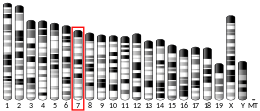GABRG3
GABAA receptor-γ3, also known as GABRG3, is a protein which in humans is encoded by the GABRG3 gene.
Function
GABRG3 is a subunit of the GABAA receptor for the neurotransmitter gamma-Aminobutyric acid (GABA).[5]
Association with alcoholism
Genetic markers near the GABRG3 gene are statistically linked to alcoholism.[6]
See also
References
- GRCh38: Ensembl release 89: ENSG00000182256 - Ensembl, May 2017
- GRCm38: Ensembl release 89: ENSMUSG00000055026 - Ensembl, May 2017
- "Human PubMed Reference:". National Center for Biotechnology Information, U.S. National Library of Medicine.
- "Mouse PubMed Reference:". National Center for Biotechnology Information, U.S. National Library of Medicine.
- "Entrez Gene: GABRG3 gamma-aminobutyric acid (GABA) A receptor, gamma 3".
- Dick DM, Edenberg HJ, Xuei X, Goate A, Kuperman S, Schuckit M, Crowe R, Smith TL, Porjesz B, Begleiter H, Foroud T (January 2004). "Association of GABRG3 with alcohol dependence". Alcohol. Clin. Exp. Res. 28 (1): 4–9. CiteSeerX 10.1.1.418.2528. doi:10.1097/01.ALC.0000108645.54345.98. PMID 14745296.
Further reading
- Greger V, Knoll JH, Woolf E, et al. (1995). "The gamma-aminobutyric acid receptor gamma 3 subunit gene (GABRG3) is tightly linked to the alpha 5 subunit gene (GABRA5) on human chromosome 15q11-q13 and is transcribed in the same orientation". Genomics. 26 (2): 258–264. doi:10.1016/0888-7543(95)80209-5. PMID 7601451.
- Tögel M, Mossier B, Fuchs K, Sieghart W (1994). "gamma-Aminobutyric acidA receptors displaying association of gamma 3-subunits with beta 2/3 and different alpha-subunits exhibit unique pharmacological properties". J. Biol. Chem. 269 (17): 12993–12998. PMID 8175718.
- Hadingham KL, Wafford KA, Thompson SA, et al. (1996). "Expression and pharmacology of human GABAA receptors containing gamma 3 subunits". Eur. J. Pharmacol. 291 (3): 301–309. doi:10.1016/0922-4106(95)90070-5. PMID 8719414.
- Poulsen CF, Christjansen KN, Hastrup S, Hartvig L (2000). "Identification and cloning of a gamma 3 subunit splice variant of the human GABA(A) receptor". Brain Res. Mol. Brain Res. 78 (1–2): 201–203. doi:10.1016/S0169-328X(00)00085-1. PMID 10891602.
- Harrington JJ, Sherf B, Rundlett S, et al. (2001). "Creation of genome-wide protein expression libraries using random activation of gene expression". Nat. Biotechnol. 19 (5): 440–445. doi:10.1038/88107. PMID 11329013.
- Nymann-Andersen J, Wang H, Chen L, et al. (2002). "Subunit specificity and interaction domain between GABA(A) receptor-associated protein (GABARAP) and GABA(A) receptors". J. Neurochem. 80 (5): 815–823. doi:10.1046/j.0022-3042.2002.00762.x. PMID 11948245.
- Strausberg RL, Feingold EA, Grouse LH, et al. (2003). "Generation and initial analysis of more than 15,000 full-length human and mouse cDNA sequences". Proc. Natl. Acad. Sci. U.S.A. 99 (26): 16899–16903. doi:10.1073/pnas.242603899. PMC 139241. PMID 12477932.
- Dick DM, Edenberg HJ, Xuei X, et al. (2004). "Association of GABRG3 with alcohol dependence". Alcohol. Clin. Exp. Res. 28 (1): 4–9. CiteSeerX 10.1.1.418.2528. doi:10.1097/01.ALC.0000108645.54345.98. PMID 14745296.
- Gole L, Crolla JA, Thomas SN, et al. (2004). "Characterization of breakpoints in the GABRG3 and TSPY genes in a family with a t(Y;15)(p11.2;q12)". Am. J. Med. Genet. A. 125 (2): 177–180. doi:10.1002/ajmg.a.20482. PMID 14981720.
External links
- GABRG3+protein,+human at the US National Library of Medicine Medical Subject Headings (MeSH)
This article incorporates text from the United States National Library of Medicine, which is in the public domain.
This article is issued from Wikipedia. The text is licensed under Creative Commons - Attribution - Sharealike. Additional terms may apply for the media files.




